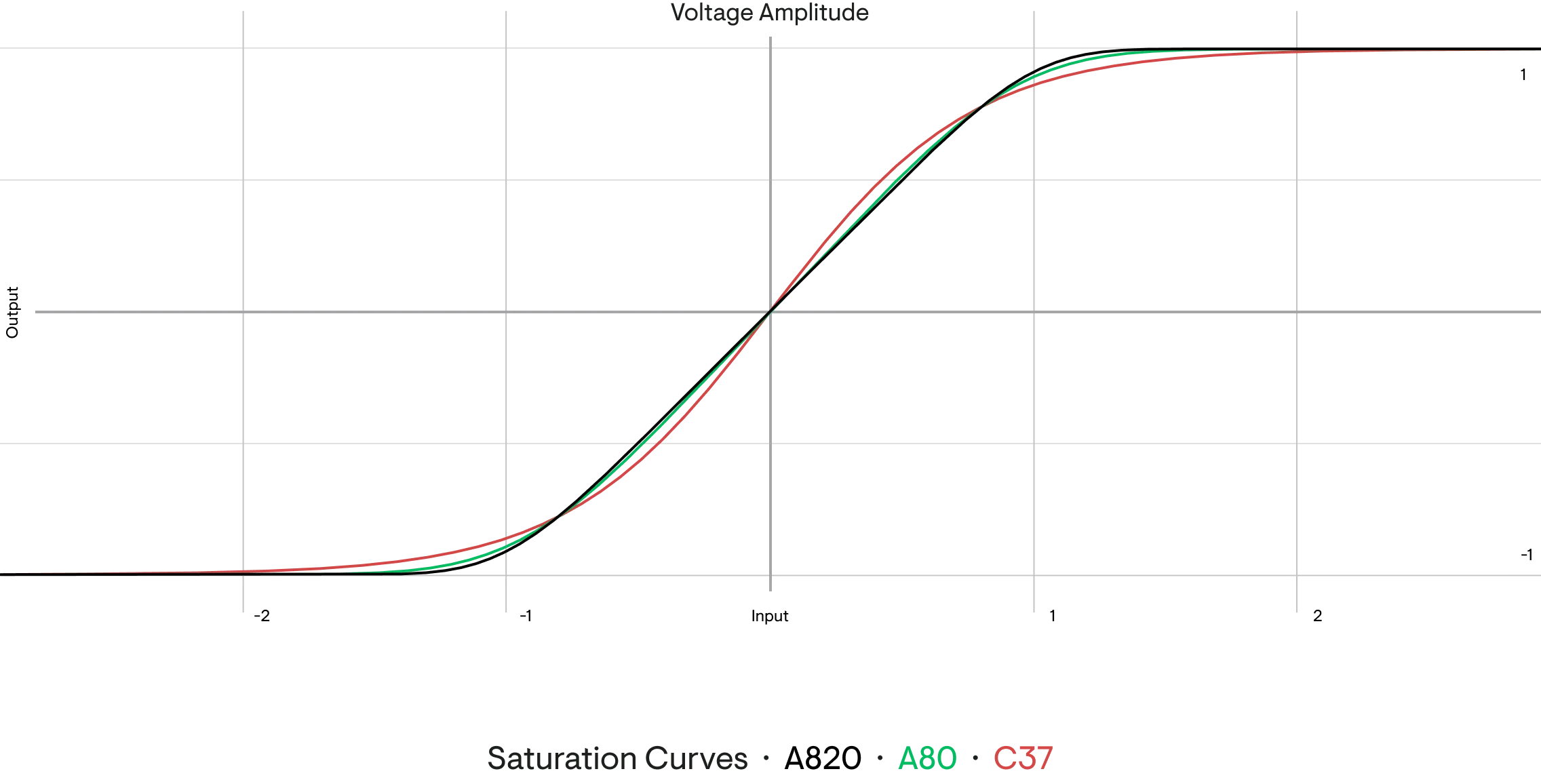Tape is a versatile colour box, inspired by the classic Studer tape decks — offering signature flavours of three generations of tape recordings
A820
Balanced, modern tone with more headroom and a harder saturation curve
A80
Low-end rich sound with softer saturation curves
C37
Low-mid and mid-range focused with scooped top and softest saturation
Max for Live device — the Tape — delivers the sound and character of the tape recording with no hassles that come with the actual tape recording process. Although it’s not trying to match the profile of any specific deck, it captures the tone, feel and vibe of the generation deck represents. Each model has its saturation curve and authentic frequency responses at two speeds — 15 ips and 30 ips. They are measured from the actual decks, but slightly exaggerated to invite more sonic exploration.
Different tape formulations further imprint signal with a particular character.
900
Balanced, flat with a slight bump at low frequency
456
The slightly more compressed character with a little spark at the top
Б3716
Based on the old Soviet-era tape for great lo-fi vibes
Audio examples
Using real time signal processing
Features
Different tape formulations further imprint signal with a particular character.
Each deck with unique character — saturation curves and authentic frequency responses
Follows the topology of the reel-to-reel deck
Three tape models based on formulations with unique compression and saturation curves
Adjustable tape hiss profile unique to each desk and tape
Authentic deck and tape wear algorithms
A sleek and convenient interface that looks native to the Ableton Live environment
Tape is Push 3 Standalone Ready
What is tape sound anyway?
When people refer to the "tape sound", they're typically alluding to the distinct characteristics imparted to audio when it's recorded on magnetic tape, especially in comparison to digital recordings. These characteristics have been deeply associated with some of the golden eras of music, making them nostalgic and often sought-after in modern music production.
Although there are many aspects of the character tape that usually imprint onto the sound, the device is focused on a few most important ones.

Saturation & Harmonic Distortion
One of the most distinctive attributes of tape is its natural compression and soft clipping, which results in a type of saturation. This adds harmonics, particularly in the lower frequencies, leading to a warm and fuller sound.

A820 has the most headroom and starts saturating only when a signal reaches around -2 dBFS, A80 has a slightly softer saturation curve with a little bit less headroom. C37 on the other hand, being an older desk has a much softer saturation curve with a lot more compressed character which boosts the quieter parts, but rolls into saturation sooner than the rest.
Natural Tape Compression
The magnetic particles on the tape have a saturation point. When pushed beyond this limit, the tape naturally compresses the signal, which can smooth out transients and add cohesiveness to the mix. This is very different from compression you may get from dynamic processors such as compressors or limiters as it happens not through deliberate dynamic adjusting circuits, but rather comes from the physical phenomenon of the way tape recording works.
Frequency Response
The tape and amplification/equalization circuits in decks can subtly shape the frequency response of a recording. Usually within ±3 dB range depending on the model and how well the deck is calibrated. The low end can feel more pronounced or rounded, and the highs might be slightly rolled off, adding to that warm characteristic. However, this can vary based on the tape speed: for example, higher speeds generally give better high-frequency response while losing a bit of low end. This is reflected in the Tape device and why it provides so much variability with just a few settings.
Wow & Flutter
These refer to the minor speed inconsistencies during playback. "Wow" is a slower fluctuation while "flutter" is faster. These imperfections can add a unique, organic modulation to the sound, making it feel more "alive."
Tape & Deck Mechanic Wear
The mechanics of a tape deck play a pivotal role in maintaining the integrity and quality of the sound. Worn-out mechanics introduce a host of irregularities and imperfections such as increased wow & flutter, tape and drive slips — which result in tonal fluctuations, and uneven frequency response — all combined while sometimes problematic, can also be harnessed creatively to impart a distinct, nostalgic character to recordings.
Tape Hiss
A background noise is inherent to tape recordings. While often seen as a drawback and something to be minimized, some artists and producers enjoy the nostalgic and "live" feel it imparts. You can adjust the amount of tape hiss in your recording with a dedicated setting.
All of these aspects combined imprint your sound with a unique character reminiscent of the old tape recordings
Monomono is a mastering house based in Riga, Latvia. We’re a collective of engineers and artists aiming to create the best tools for producers.
Why Ableton Max Devices?
Most of the artists we’re working with are using Ableton Live to produce their music. We’re using it as well, as it’s a wonderful tool for musicians and engineers with a great set of composing and mixing tools available.
While there are plenty of incredible plugins in the world, we felt there was room to bring our ideas directly to your Ableton workflow.
While most of the plugins have a code obfuscated for obvious reasons, we felt the opportunity to actually look behind the curtain and see the process is valuable to understand what is happening and how it works. We appreciate the transparency Max devices bring to digital signal processing.
Our experience at mixing, mastering and engineering and the power of Max, allowed us to bridge the gap and provide a new set of native-to-Ableton, beautiful-looking, and sounding devices that are easy to use and enjoy.